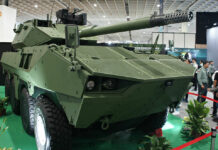India has become a big consumer of defense electronics, which, like some of their major military systems, are based on foreign systems but developed indigenously and locally produced. The largest defense electronics exhibitor at Defexpo 06 was Bharat Electronics (BEL), which displayed a wide range of electronic equipment including battlefield surveillance radars; SIGINT; electro-optical systems for upgrading tanks and air defense systems; and communications gear for land, air and naval use. The planned expansion of India’s recently fielded military communications networks to address mobile access capabilities (Tactical Communications Systems – TCS program) attracted considerable interest. The TCS program envisions extending a division’s communications infrastructure from the base and office to the field. Thales and Tadiran, both traditional suppliers of communications equipment to India, responded to the challenge at Defexpo 06.
France’s Thales Land & Joint Systems Division demonstrated its DI@NE IP based voice and data networking solution for the Indian TCS program. The system is comprised of TRC-4000 microwave links and integrated tactical radios, secure battlefield WiFi terminals (BattleLan), and Cisco routers, all controlled by a central network management system. They also displayed their TRC-400 high capacity Line Of Sight (LOS) radio equipment operating on Band 4 (4.4-5GHz), and supporting up to 34 Mbps data transfer rates. They also promoted the tactical satellite communications capability of the SATMOVE QUICK HALT terminal which operates in the X-band (7.9 – 8.4 GHz and 7.25 – 7.75GHz) using a low profile foldable 1.8 meter antenna, and supports full duplex voice communications and data rates of up to 2 Mbps. The system can be set up and ready for operation in less than 10 minutes.
Tadiran Communications from Israel introduced its comprehensive TCS concept, which is based on combat proven systems such as the GRC-408 and GRC-2000 LOS radio systems, both of which operate in Band 4. The GRC-408 provides a high capacity network backbone with up to 34Mbps data transfer rate links. The GRC-2000 delivers 2Mbps (E!) data rates, and supports fast frequency hopping (FFH) over TDMA combined with FDMA regime to deliver reliable communications even when subjected to severe electromagnetic interference and countermeasures. Tadiran’s TCS supports a variety of protocols, including EUROCOM, ATM, LAN/WN IP, PCM and Radio over IP/Voice over IP telephony (RoIP/VoIP).
A new command and control system, designed specifically for small infantry units and special operations forces, was displayed for the first time by IMI and IAI/MLM. The system, known as MPRS C3I, integrates several new devices, including the Tavor assault rifle and its Multi-Purpose Rifle Sight (MPRS) system, the Reconnaissance Rifle Grenade (RRG), radio location reporting, and rugged PDAs, in order to enable commanders to plan and debrief operations without having to rely on external support (intelligence, geographical files, images etc). Real-time reporting and video feeds enable commanders to develop a better situational picture at all levels. MPRS and WACT, which are subsets of this system, were covered in previous reports. The new element unveiled at Defexpo 06 was the commander’s display, which supports situational display and automatic, dynamic views of targets from different directions based on processed image metadata. The system uses images that can be collected by the unit from video or still images taken live by UAVs, RRG, MPRS sights or ground observations and maintained independently in a local database.
Several jamming systems were displayed indicating India’s interest in this field. Among the systems on display was the Liman airborne datalink jammer from the Ukraine firm CARI, and the Granat RF jammer, which can be used to neutralize some radio controlled IEDs. These devices have been field tested by Ukrainian Army units deployed for peacekeeping missions in the Middle East. The jammer operates over a wide frequency range. (20-2000 MHz)
















